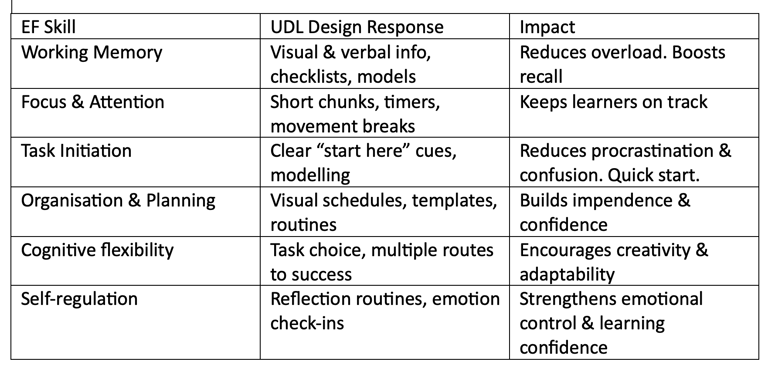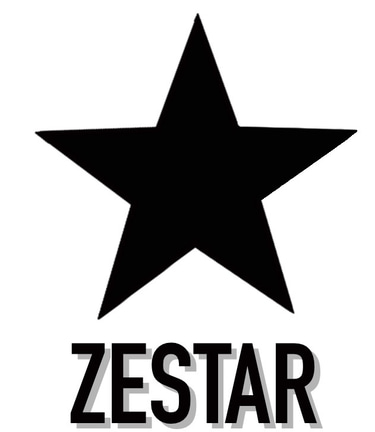Universal Design for Learning
How to use UDL principles to design accessible lessons for all
Jocelyn Mayo
11/7/20253 min read


How Universal Design for Learning (UDL) can transform lesson planning & delivery
Ever finish a lesson feeling like it landed perfectly for some students — but others, well… quietly drifted off? Or lost focus and distracted others? Every classroom is a mix of brains that plan, process, and focus in wildly different ways. And let’s be honest: teachers don’t have the time to write multiple lesson plans to cater to every individual. The good news? By applying the principles of Universal Design for Learning (UDL), you don’t need to. One thoughtfully designed lesson can work for all learners — improving engagement, clarity, and access across the board. Best practice doesn’t mean creating multiple plans; it means designing one lesson to optimise learning for all.
What is Universal Design for Learning?
UDL is a research-backed approach that helps educators create lessons that work for all learners — not by lowering the bar, but by building flexibility and accessibility into the design from the outset.
Developed in the 1990s by David Rose and Anne Meyer at CAST (Center for Applied Special Technology), UDL is rooted in neuroscience and cognitive psychology. The central idea is that every brain learns differently, and that variability is the norm, not the exception.
UDL revolves around three core principles:
1. Multiple Means of Engagement – the “why” of learning
This is about motivation, interest, and persistence. Why does a student care about this lesson? How do we spark curiosity, keep attention, and sustain effort? Engagement taps into the emotional and social drivers of learning — so it’s the “why” behind their participation.
2. Multiple Means of Representation – the “what” of learning
This is about content delivery. What are we teaching, and how can we present it in different ways so all students can understand it? Text, visuals, audio, diagrams, hands-on activities — this principle recognises that the same “what” can land very differently depending on the learner.
3. Multiple Means of Action and Expression – the “how” of learning
This is about demonstration of learning. How can students show what they know in ways that make sense for them? Writing, speaking, drawing, building, performing — this principle ensures learners aren’t limited by the format of assessment or output.
In short:
Why: Engagement → Why students care, stay motivated.
What: Representation → What students learn and how it’s presented.
How: Action & Expression → How students demonstrate learning.
When lessons are designed with these principles front and centre, barriers vanish before they appear, and learning becomes more inclusive — and more fun — for everyone.
Where has UDL been adopted?
UDL isn’t just theory; it’s policy in practice in several countries:
United States: Embedded in federal law (Higher Education Opportunity Act 2008, Every Student Succeeds Act 2015). Many states now include UDL in teacher certification.
Canada: Ontario and Nova Scotia have fully baked UDL into inclusive education frameworks.
Australia & New Zealand: Growing adoption through teacher training and curriculum design.
Nordic countries: Norway and Finland use UDL to guide national inclusion strategies.
United Kingdom: Awareness is spreading, but adoption is patchy. Some MATs (Multi-Academy Trusts) are trailblazing, embedding UDL into curriculum and CPD, but most teacher training programmes barely touch it.
UDL vs “Chalk and Talk” Lessons
Many classrooms still rely on the “chalk and talk” approach (or, these days, a string of PowerPoint slides): the teacher talks, students listen, and everyone completes the same task. Efficient? Maybe. Engaging and accessible for all learners? Perhaps not.
The difference isn’t gadgets or gimmicks — it’s design intention. A UDL classroom starts with: “What barriers might exist for my learners, and how can I remove them before they appear?”
UDL and Executive Function
Every student comes with an executive function (EF) profile — a unique mix of focus, planning, organisation, working memory, and emotional regulation skills. Some have diagnoses like ADHD or ASD; most just have uneven EF development, especially in adolescence.
UDL supports these skills directly by using best teaching practices and smart lesson design to accommodate a range of executive function profiles — helping every learner build the skills they need to succeed, not just absorb content.
In conclusion
UDL isn’t just another initiative. It’s a mindset shift: from “How do I differentiate for a few?” to “How do I design so everyone can learn?”
It benefits high achievers as much as it supports those who struggle. Why? Because it puts clarity, structure, and motivation into the heart of every lesson.
In a world where Executive Function, wellbeing, and inclusion are key to student success, UDL builds a bridge between neuroscience and classroom practice, and teacher can start building that bridge today.




